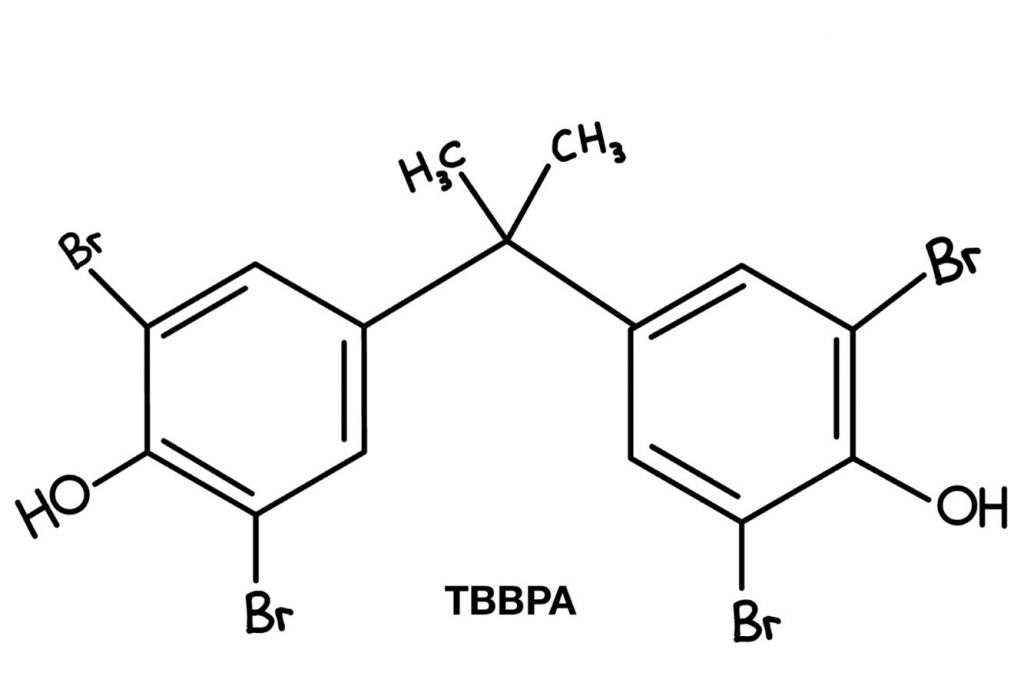1,1'-[ethane-1,2-diylbisoxy]bis[2,4,6-tribromobenzene] (BTBPE) | 37853-59-1 | Persistent, bioaccumulative, and toxic (PBT) | - Additive in flame retardants and in thermoplastics.
- Acrylonitrile butadiene-polystyrene (ABS), high-impact polystyrene (HIPS) resins, including electronics, electrical products, and some construction materials.
| 1 |
2,2',6,6'-tetrabromo-4,4'-isopropylidenediphenol (Tetrabromobisphenol A) (TBBPA) | 79-94-7 | Carcinogenic | Brominated flame-retardant used in: - epoxy coated circuit boards
- printed circuit boards
- printed wiring boards (PWB)
- paper
- textiles
| 2 Is also an EU RoHS candidate substance and a California Proposition 65 chemical |
4,4'-sulphonyldiphenol (BPS) | 80-09-01 | - Toxic for reproduction
- Endocrine disrupting properties
| - Used in thermal paper, leather products, and recycled paper.
- Used in the manufacture of Polyethersulfone (PESU) polymer, Synthetic tanning agents (Syntans) (e.g., for tanning in leather production), and polymers.
| 3 |
Barium diboron tetraoxide | 13701-59-2 | Toxic for reproduction | - Coating of PVC truck foil and electrical wires.
- Paints, coatings, thinners, and paint removers.
| 4 |
Bis(2-ethylhexyl) tetrabromophthalate (TBPH) covering any of the individual isomers and/or combinations thereof | - | Very persistent, very bioaccumulative (vPvB) | - Electrical/electronic articles
- Plastic and rubber articles e.g., flexible PVC, wires, and cable insulation
- Adhesives and sealants
- Additive in flame retardants
- Film and sheeting, carpet backing, coated fabrics, and wall coverings
- One component foam e.g., polyurethane foam
| 5 |
Isobutyl 4-hydroxybenzoate (IBP) | 4247-02-03 | Endocrine disrupting properties | - Coating and paint products, fillers, putties, plasters, modelling clay, inks, and toners
- Intermediate in chemical production or refinery processes
| 6 |
Melamine | 108-78-1 | Probable serious effects on human health and the environment | - Production of formaldehyde-based resins often used in the woodworking industry (e.g., laminate flooring, wood-based panels, surface-coating panels).
- Coatings for foams and to produce consumer goods like tableware.
- Intermediate for adhesives, lacquers, pigment, coatings, inks, rigid foams, polyurethane foams, rubbers, and polymers often used for fire safety applications.
- Leather manufacturing processes.
| 7 |
Perfluoroheptanoic acid (PFHpA) and its salts | - | - PBT and vPvB
- Toxic for reproduction
- Probable serious effects on human health and the environment
| - Stain or water repellent
- Wetting, dispersing, emulsifying, and foaming agents
| 8, 9 |
Reaction mass of 2,2,3,3,5,5,6,6-octafluoro-4-(1,1,1,2,3,3,3-heptafluoropropan-2-yl)morpholine and 2,2,3,3,5,5,6,6-octafluoro-4-(heptafluoropropyl)morpholine | - | vPvB | - Formulation into mixtures
- Industrial and professional use in closed systems. E.g., it is used as a laboratory reagent and as a functional fluid at an industrial site and indoors.
| 10 |



